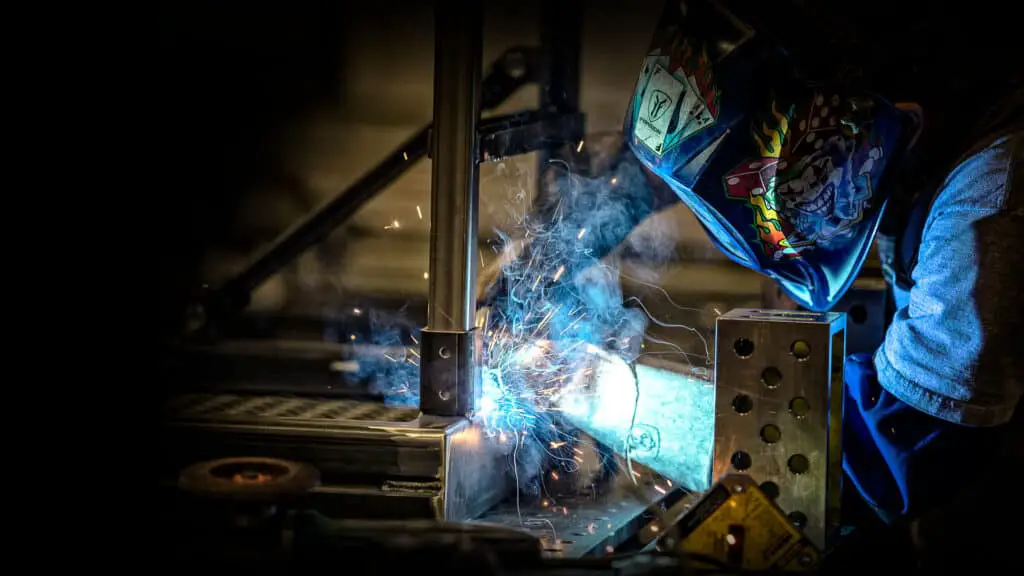We all have seen the arcs coming out of a welding store and have wondered what’s in the making!
When I was a kid, I used to wonder how brave the mechanics are to handle such violent arc and remained amazed about their craftmanship!
 Now, who would have known that while I grow up, I would be in the welding industry myself!
Now, who would have known that while I grow up, I would be in the welding industry myself!
And now I know that those arc sparks were from arc welders used in fabrication and welding to make huge buildings and vehicles!
Yes, arc welding traces back its history to the 19th century and have been used extensively till the present date for fabrication and welding of various metals and one amongst those metals is aluminum…
And today in this article I am going to discuss about how to weld aluminum using an arc welder!
But before we start, you need to know that aluminum is a very difficult metal to weld because of its very high thermal conductivity and low melting point! Therefore, you need to be very specific with the temperature and amperage settings and tools and the steps to weld aluminum.
Arc welding produces a lot of heat which can melt aluminum easily because of its low melting point. Therefore, you need to set the amperage setting to very low when you begin arc welding aluminum. Also, you need to clean up the aluminum metal to be welded, preheat it and increase the travel speed before you actually begin with the arc welding process.
Well, there are even more detailed steps to arc welding aluminum which I will be discussing below…
How to Arc Weld Aluminum?
Arc welding aluminum is not that easy. In fact, it is very troublesome especially if you are a first timer! It will require patience and expertise to arc weld aluminum.
But, don’t you worry because I am going to share with you all the minutest details regarding the steps to arc weld aluminum so that you don’t miss out on any point:
Step 1: You need to prepare the surrounding before you begin with the arc welding:
Arc welders uses flux cored electrodes and there is no use of any shielding gas in this process which can be disrupted because of the wind. Also, arc welding produces a lot of heat and flame which can easily ignite surrounding items if they are combustible.
Therefore, the best and safest place to arc weld aluminum is outside where is enough open space and no chance of any ignition of surrounding items.
This is also feasible because arc welders can operate effectively in wind up to 35 mph! so, if the weather around is not stormy, you can effectively arc weld aluminum in the outdoors.
Step 2: Protecting oneself against the odds by wearing personal protective equipment:
Arc welding not only produces fumes and arc but also the heat is unbearable ranging from 5000 degrees F to 20,000 degrees F. Therefore, every part of your body needs to be protected from those burning hazards!
Let’s start with the hands; wherein you need to hold the electrode in the arc in order to melt it and therefore, your hands need to be protected from the heat and burn and you can do so by wearing a flame and heat resistant gloves.
The sparks, arc, molten spatter etc. can reach out to any part of your body and you can prevent burns from them by wearing flame- and fire-resistant vests and aprons.
The fumes and the heat can reach your eyes and irritate and harm them and you can protect them by wearing anti-fog safety glasses with tinted lens that protects against glares.
Other safety equipment would include wearing safety helmet, a respirator for protecting your lungs from the fumes and an EH rated work boots.
Step 3: Preparing the aluminum before beginning with the welding:
As I have mentioned that arc welding is the safest when carried out in the open space preferable outside. But there is one problem to it when you are going to arc weld aluminum in the outside and that is aluminum is a very reactive metal and it is especially reactive to oxygen which is abundant in the earth’s atmosphere.
When aluminum comes in contact with atmospheric oxygen, it immediately forms a coating of aluminum oxide on its surface.
Therefore, you need to first of all remove the oxide coating from the metal before you actually begin with the welding. And you can do so simply with the use a wired brush and then using a sandpaper.
At first, you need to remove the oxide coating with the help of the wired brush and then remove any surface dirt or remains of the oxide using the sandpaper.
See also: What Flame Type is Used for Welding Aluminium?
Step 4: Preheat the aluminum in order to avoid the dissipation of heat:
Aluminum has a tendency to dissipate heat therefore, it is necessary to preheat the metal and the best temperature for it is below 400 degrees F.
You can check the temperature with a thermometer, also, you can understand your aluminum is ready to weld once the surrounding soot is all gone.
When you start heating the aluminum with the torch, it will first start producing soot, you then need to adjust the torch to medium heat and move it all round the metal.
Doing this will remove the soot from the metal and you will come to know that your aluminum is all ready for the arc welding process.
Step 5: The actual arc welding process of Aluminum:
Requirements:
-
-
- Set the amperage setting of the machine to 85 amps
- Use DC in reverse polarity
- The polarity of the aluminum electrode should be electrode positive
- Angle the stick following the angle formed at the center of the joints. For example, if the two aluminum plates are placed at 90 degrees to each other, then angle the electrode at 45 degrees
- You have to perform 2 tack welds at the either ends of the metal plates.
- As soon as you strike the first arc, maintain brisk but fast travel speed
- Maintain a steady and low arc at the weld pool
-
Step 6: The final cleanup of the mess:
Arc welding aluminum creates a lot of mess unlike other metals. Therefore, you need to clean up the slag as soon as it is formed otherwise it will interrupt the weld.
Begin with by dipping the aluminum in water as soon as the first layer of slag is formed. This is because the slag is impossible to clean off when hot.
Then you need to make use of a chipping hammer to take off the pieces of slag and then clean up the rest of the mess using a wire brush. If you want a cleaner weld, follow up with a sandpaper.
See also: Is Welding Steel to Aluminium a Bad Idea?
Pros and cons of arc welding aluminum:
Yes, arc welding aluminum has some cons as well as it has the pros. Let’s have a look at some of them:
Pros of arc welding aluminum:
-
-
- High quality weld
- Greater completion speed
- Effective for huge projects as welding time is less
- No need of any shielding gas
-
Cons of arc welding aluminum:
-
-
- Lot of mess at the weld pool
- Formation of slag
- The weld pool becomes erratic if it comes in contact with the oxide
- Prior clean up of the metal is required
- Post clean up of the weld is also required
- Risk from the arc
-
Alternative method to arc welding aluminum:
Yes, there is obviously an alternative method to arc welding aluminum but that is suited for smaller and more detailed projects, uses shielding gas and requires more time than arc welding and that is MIG welding of aluminum.
But there are some advantages of MIG welding aluminum over arc welding and they are:
-
-
- As there is no flux cored electrode and instead a shielding gas is used, therefore, there is less mess created at the welding pool
- The weld produces less slag and produces a cleaner weld
- No preheating of the aluminum is required
- The weld bead is cleaner and therefore you do not require any post clean up
-
See also: MIG Vs TIG Welding Aluminium: Which One is Better?
Comparison of arc welding and MIG welding aluminum:
| Arc welding aluminum | MIG welding aluminum |
| Flux cored electrode is used | Shielding gas is used |
| You can arc weld outside | You cannot MIG weld outside because of the presence of the shielding gas |
| Faster method | Takes a bit longer |
| Risk from the arc | No risk from heat and arc |
| For huge projects | For smaller projects that requires details |
| More mess at the weld pool | Less mess at the weld pool |
| Requires post clean up | Does not require post clean up |
| Produces slag and ugly weld beads | Produces cleaner weld beads |
And It’s a Wrap!
That’s all with arc welding aluminum! Hope you have enjoyed reading my article! Stay tuned for exciting posts on welding and never miss any information that you might be in need of!
So, catch you in my next post… Till then…
Have a happy welding day!






